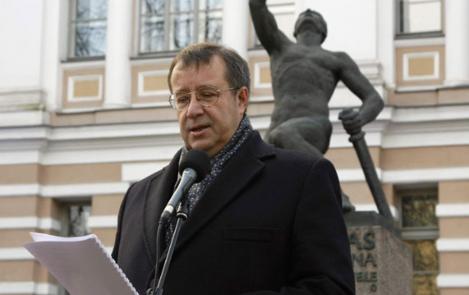-
Reset
+


President of the Republic at the Monument of the Student-Soldier of the War of Freedom at Tallinn Secondary Science School, 13 November 2007
13.11.2007
Dear students, dear teachers, dear friends!
We have gathered here today to celebrate the 80th anniversary of the raising of this monument to the schoolboy-soldier. We have all heard of the trials and tribulations that this statue, sculpted by Ferdi Sannamees, has undergone. I am not going to relate them once again. After all, statues are mere symbols. They symbolise, they signify things that have been. Or – as we also know, only too well – things that have never existed outside false history.
Yet this small statue of Estonian modesty, which has a long sad history of its own, signifies something very noble in the history of the people of Estonia. It signifies the contribution of those young men, schoolboys really, who formed voluntary units under the command of Estonian officers from the Tsar’s army, and were the first to face the violent offensive of the Red Army.
Those boys, and also girls, had no equipment to speak of. There weren’t many uniforms to go round, and their weapons were old and of Russian or Japanese origin. The so-called armoured trains, built of sand and plywood, in which the students faced the Red Army in December 1918, had been constructed in Tallinn by the schoolboys themselves.
Yet historians consider the contribution of those school-leavers to have been crucial to the outcome of the war. Let me quote the historian Hannes Walter:
"There is perhaps no need to prove that the Republic of Estonia would never have been born if our schoolboys and students had not taken to arms at the critical moment and without hesitation risked their lives for Estonia’s independence."
To my father, who was a realist, I owe my acquaintance to an even older realist Ilmar Raamot. He was one of the boys who volunteered to fight in the War of Freedom at Christmastime in 1918, when the faith in Estonia’s freedom was still scarce.
The Estonian state was still under formation. The German troops had barely left Tallinn, the Defence League was still being formed, and the Russian Army was advancing towards Tallinn. On 26 December, schoolboys, 17 or 18 years of age, set off to the front. Leaving school behind, Raamot and – as he ironically calls it – his "strike force", in inverted commas, arrived at the front, which was already on this side of Tapa, conquered by the Red Army.
The strike force had been divided into smaller units according to schools, and all such units were in fact known by the name of the school. In the first battle, the officer beside Raamot was killed, as well as the machine-gun operator to whom Raamot had been feeding cartridges.
A year later, the 18-year-old schoolboy had become an officer and company commander. He had been at war, he had helped to found the Republic of Estonia and thus given the people of Estonia, our parents and grandparents – that is to say, to all of us – the chance of survival, which otherwise would have been doubtful – I wonder how many of us would have been here today if Estonia had not been an independent nation in 1920 – 1940.
Of nearly two thousand Crosses of Freedom bestowed on the people of Estonia, 600 were awarded to schoolboys and 150 to students. On the average, one man in fifty was awarded the Cross of Freedom – yet it was awarded to every third student and every eighth schoolboy. In this manner, 5400 schoolboys and students, and their officers, formed the core of the Estonian Army, whose actions decided the fate of Estonia at a crucial moment.
Of the contribution of youth, General Laidoner said the following: „The schoolboys brought us faith that we would win, and that is the greatest gift given to the Republic of Estonia at her birth.”
Let us remember – let us remember the contribution of those schoolboys and girls, of which this statue here is a symbol. And let us all ask ourselves, standing here on this cold November day – would we be prepared to show the same commitment to our country as they did in their day?



